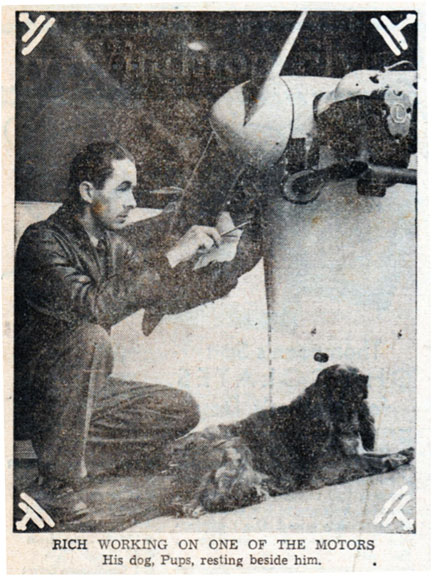

 |
| RICH WORKING ON ONE OF THE MOTORS His dog. Pups, resting beside him. |
For the almost 20 years that he has been interested aviation, Bud Rich has found that small planes which come within the reach of the needs and purse of the private flyer have been "full of compromises." His experience includes ownership of 17 aircraft of many types.
No one plane filled the demands which were made upon it, and Bud Rich found himself making notes of the desirable features of each craft. Working in his aviation repair shop at the airport brought him in daily contact with the complaints and the praises, too, which pilots had for the planes they flew. In his mind, Bud Rich pieced together a plane which he dreamed would be a panacea for the ills besetting private aircraft.
Several years ago, as an instructor in a Summer aeronautics course at Massachusetts Institute of Technology, Bud Rich made the acquaintance of three other aviation students, now placed in responsible positions with aircraft companies. To these men, James Kendrick, now of Glendale, Calif.; William Cook of Seattle, Wash., and Robert Wittington of M. I. T., he broached the idea he had. Joining his practical knowledge to their technical and scientific skill, plans for the "amend-all" plane were put on paper. Construction began a year ago under Bud Rich's watchful care.
Assembled the plane has a wing spread of 35 feet and measures 21 feet from its snub nose to the twin tails.'' Motors and all, the tiny craft weighs a little more than 1500 pounds. A radical departure from previous aircraft design, the twin, 50-horsepower engines are housed in what resembles the turret of a warship. The engines are of the "pusher" type, that is, propellers are toward the tail of the plane rather than facing forward.
The two "turrets" jut from the wings to the side and rear of the pilot's seat. Sad experience taught Bud Rich that motors placed at the nose of the plane directly in front of the pilot's cockpit reduce visibility on the ground to practically zero. Innumerable ground accidents have been attributed to the poor visibility afforded pilots whose view is obstructed. Vibration from a motor placed forward of the cockpit, Bud Rich found, was transmitted to the pilot's seat and was particularly wearisome on flights of any distance. In Bud Rich's low-slung monoplane, the pilot has unobstructed vision in three directions and is removed from the source of engine vibration.
Unlike its winged kin, the petite yellow monoplane rides on a three-wheeled landing gear. From his book of experience, Bud took this tri-wheel arrangement to give greater safety and facility in ground handling, landing and taking of. As a result of this feature, Bud finds his plane can land with ease in a down-wind or up-wind, usually dangerous to ordinary craft.
 |
| BUD RICH, HIS PLANE, AND MECHANICS WHO HELPED HIM Left to Right - Nelson B. Rich, Perry Balentp, Russ Johnson, Clifton Pope and Edward Ziedalis. |
Comfort, speed, safety and facility in handling both in the air and on the ground, which have been the aims of the smiling, young designer, have been realized in a large measure, he said, as a result of the first test flight. Mechanics and pilots at the airport, who have watched the growth of the strange looking ship, were enthusiastic spectators and critics. Their reports, Bud noted, were most encouraging.
Although the present dimensions provide places for only two passengers, the plane can be scaled to carry as many as four. The craft is primarily for private owners ship and operation. The aim is to meet the demand for a "middle-class" plane.
Mrs. Rich, the former Alberta Pigon, daughter of the Winthrop Town Accountant, Albert L. Pigon, is an ardent admirer and interested observer of the progress of the little plane.